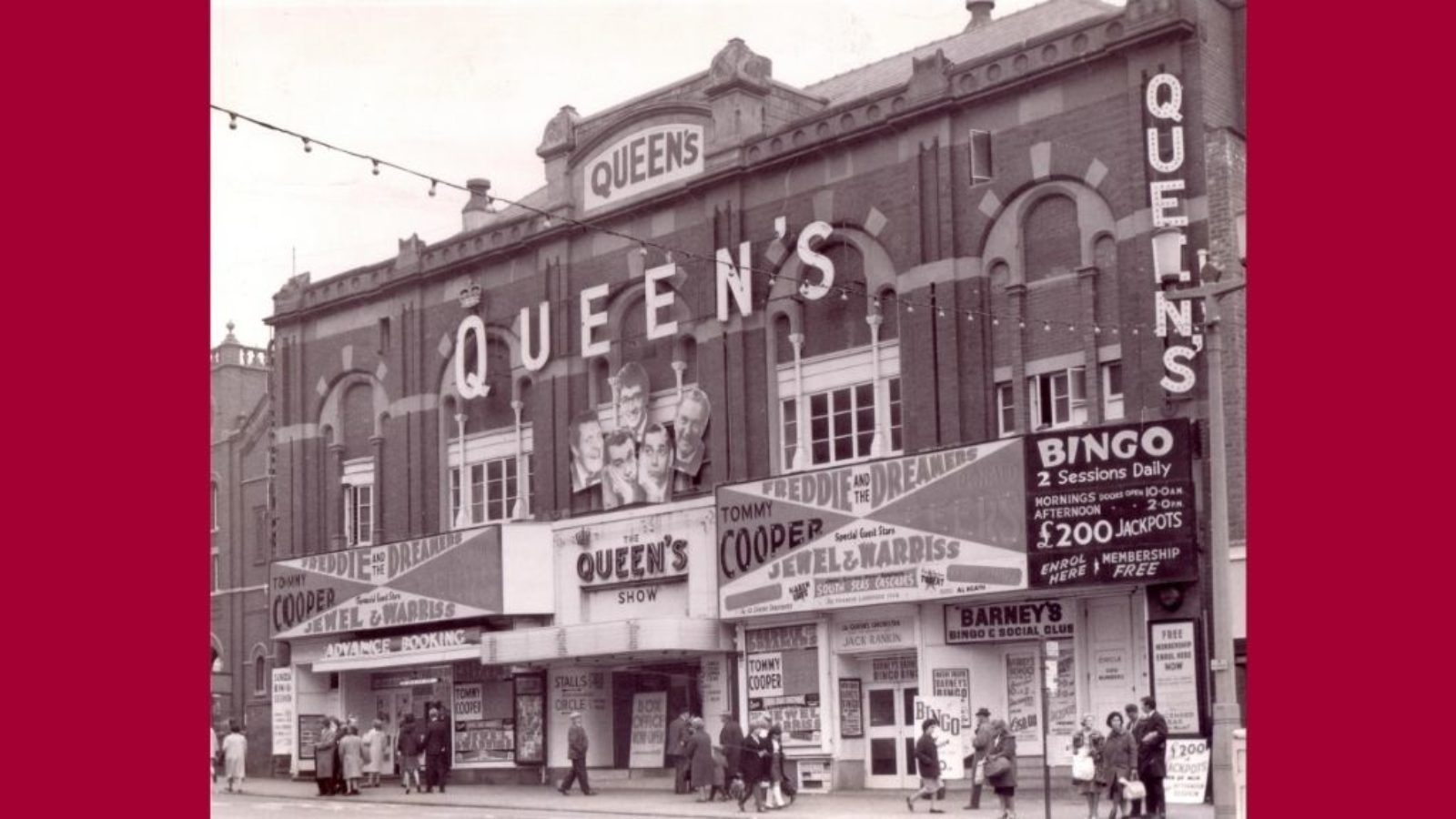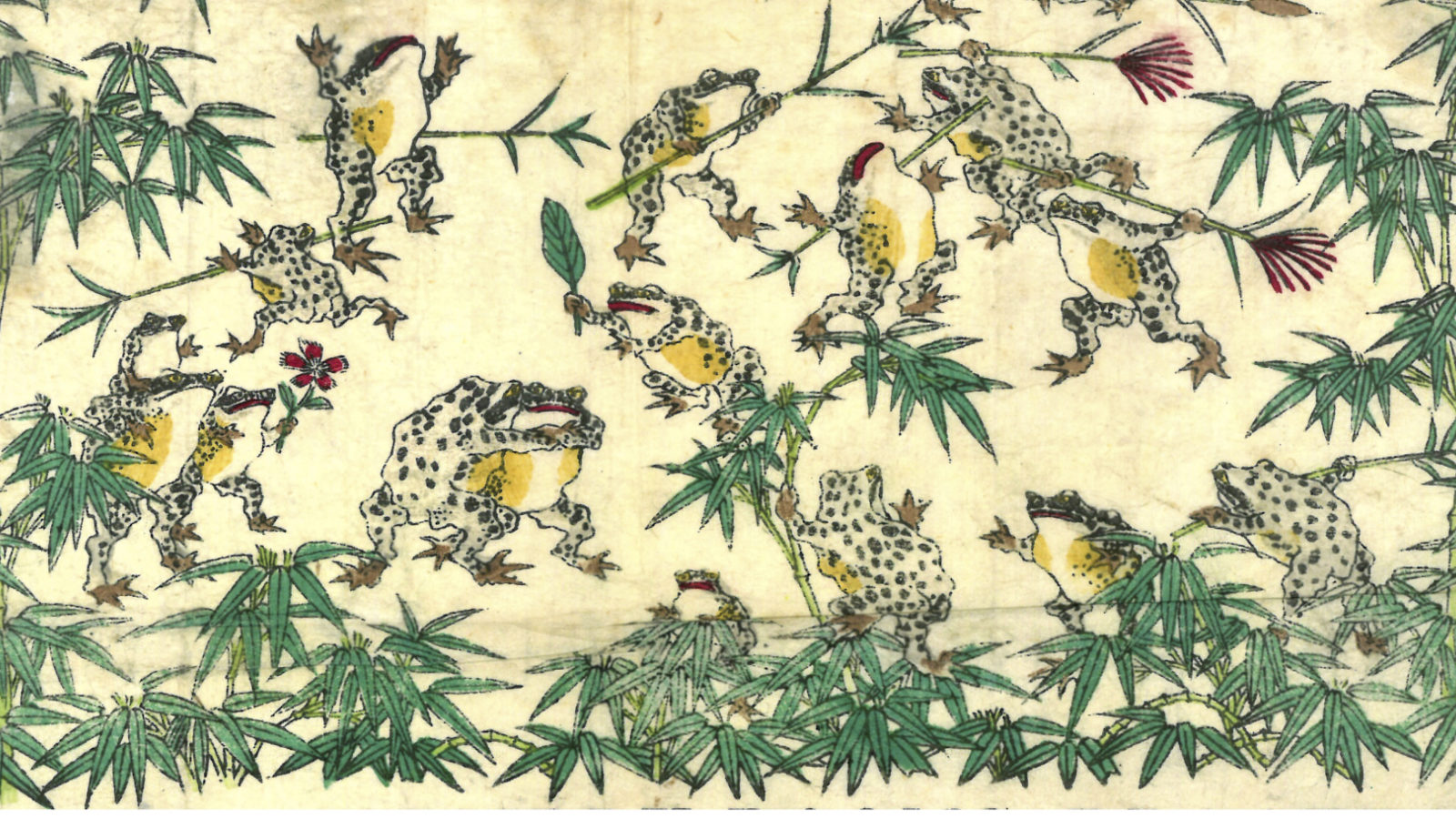Oriental Bazaars, Mermaids and Pioneering Photography Come to Blackpool
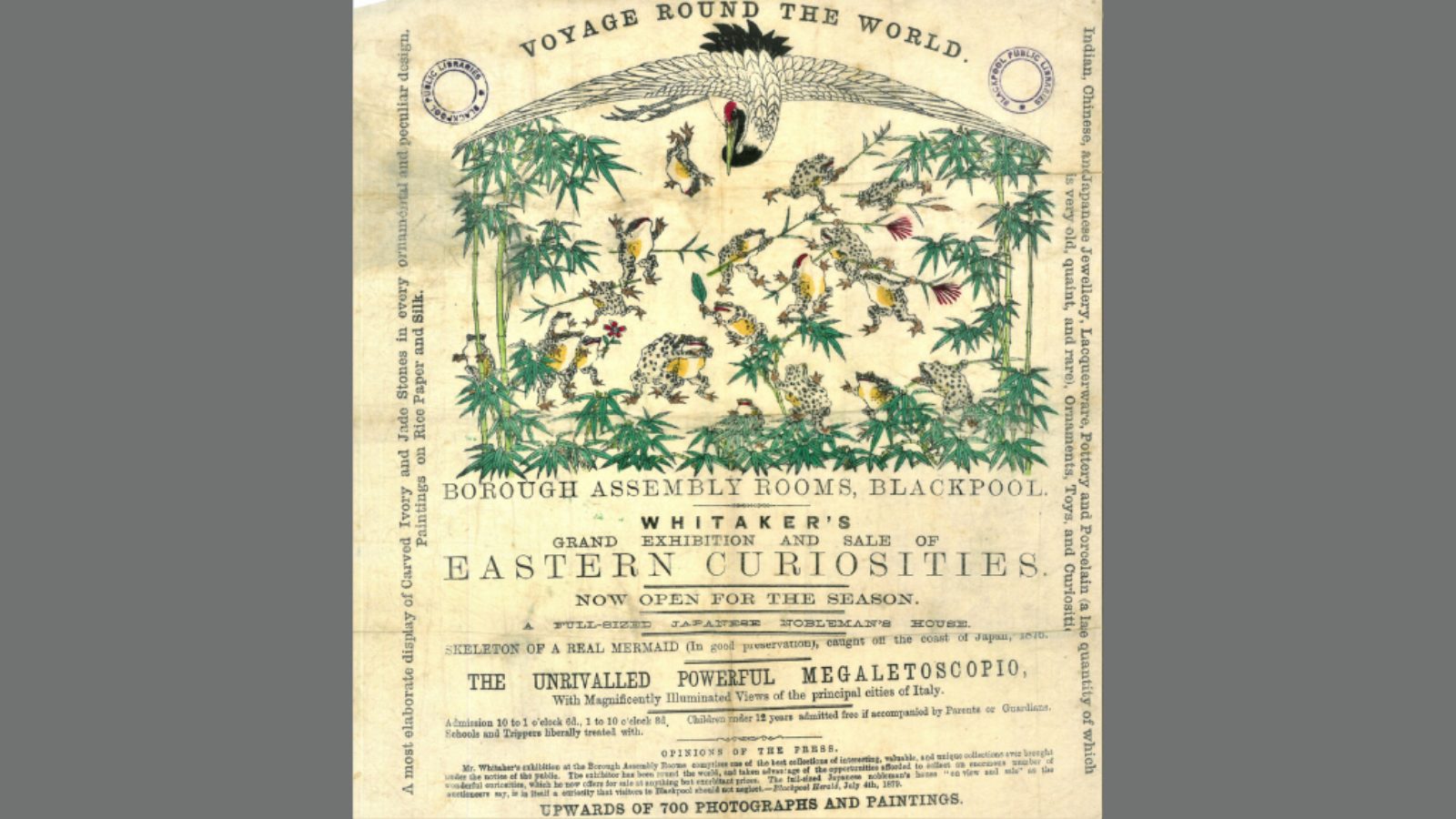
This beautiful and fascinating item is from the collection of Heritage Blackpool. Printed on fragile rice paper, it is an advert for an exhibition and sale to be held at the Borough Assembly Rooms, Blackpool in 1879. When this item was discovered we knew nothing about this event and it raised many questions. What were the Borough Assembly Rooms? What were these Eastern Curiosities? Who was Whitaker, where did he get a genuine Japanese Mermaid, and why was he displaying it in Blackpool?
Read on to discover the amazing story of Whitakers Grand Exhibition and Sale of Eastern Curiosities.
During the late 1700's-1800's global travel became easier as European empires expanded across the world and steam ships and railways became more common. More and more wealthy European travellers and traders began to explore, and in doing so they developed a fascination with the exotic cultures of what came to be known as the Orient, a general term for the varied countries of the east.
A flood of goods imported from these eastern countries began to be sold in Europe and these newly revealed cultures became hugely fashionable. This had a big impact on art, design, literature and architecture during this period. This can be seen in buildings such as the Royal Pavilion in Brighton, which was remodelled between 1812 and 1822 to add Indian and Islamic features which can still be seen today. Designers such as William Morris (1834-1896) introduced elements of Islamic patterning into his designs, alongside exotic plants such as lotus flowers and pomegranates. Artists like Pre-Raphaelite William Holman Hunt (1827-1910) travelled to the middle-east and returned with paintings showing this unfamiliar land to British audiences.
A new type of shop influenced by the covered markets of the Middle East also emerged in Victorian Britain, the bazaar. Traditional British shops had tended to focus upon selling goods related to one particular trade, and the shopkeeper would serve the customer from behind a counter. Bazaars, however, contained lots of different types of goods all under one roof, like a market, and customers were encouraged to browse for themselves. Bazaars were also defined by their open spaces, grand architecture, rich decoration and flexible use of the space. Many bazaars included tea rooms, picture galleries, winter gardens, aviaries, dioramas and other live entertainments. They were beyond a simple shop, they were a leisure experience.
The term bazaar evolved to describe any retailer that traded in a wide variety of goods, including auction houses, market stalls, charity fairs and what we now know as department stores. In fact Marks and Spencer started out as a 'Penny Bazaar' on Leeds market in 1884.
The Borough Bazaar and Theatre
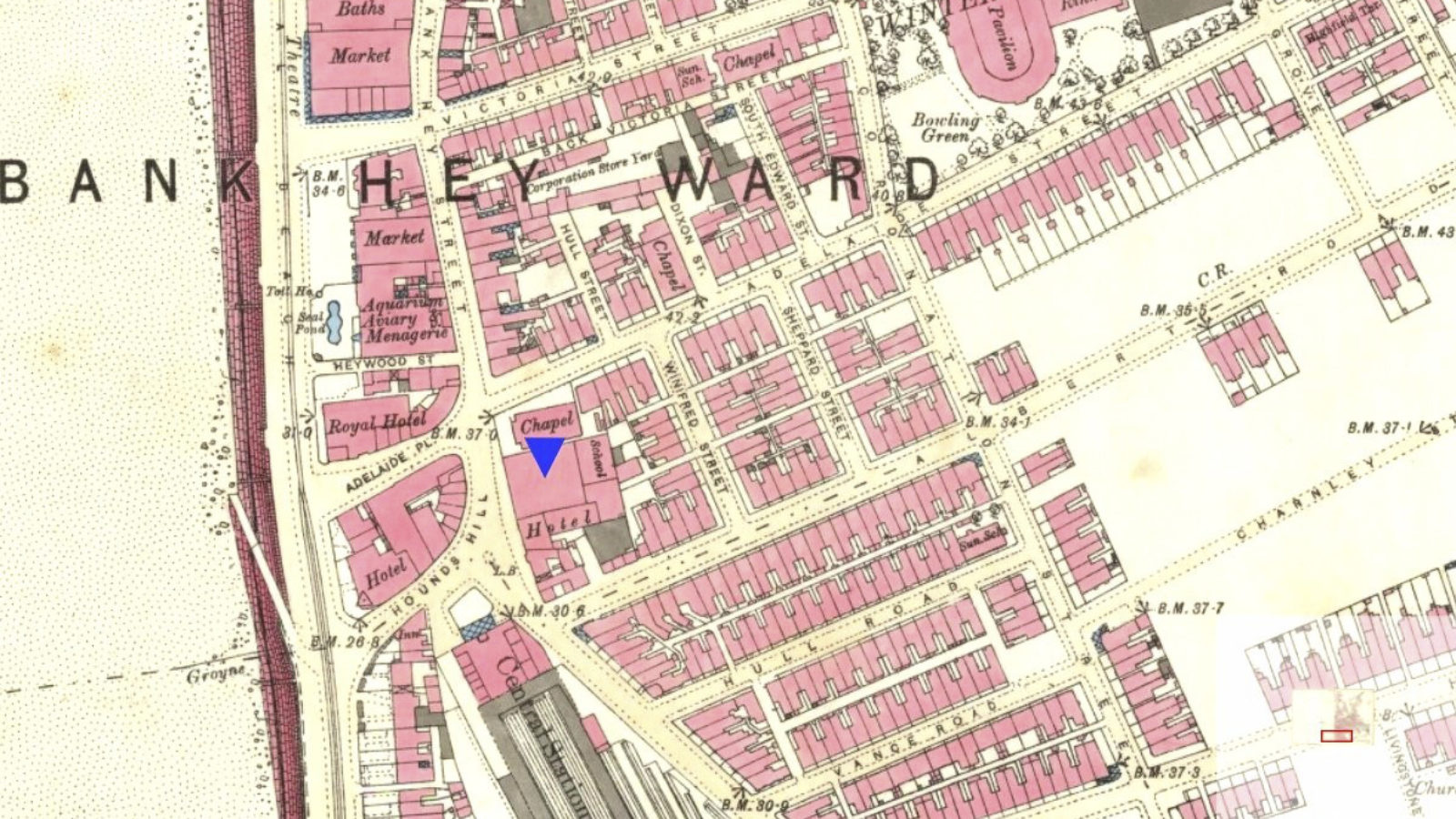
Designed by architect Thomas P. Worthington, the Borough Bazaar and Theatre was built and opened in 1877 on Hounds Hill, Blackpool, in a mixture of Italian and Gothic architectural styles. Its location was chosen so it was visible from the Promenade between the Palatine Hotel and New Inn.
The Chairman of the Borough Bazaar Company was Mr John Wade, who laid the foundation stone on 11th January 1877. In his opening speech at the ceremony, he declared that he and his fellow investors saw the Bazaar as a sure sign of Blackpool's progress. He pointed to the rapid growth of facilities; with the recent construction of the Palatine Hotel, the market place and new railway station in the same area, as a motivation for the location of their new enterprise.
The interior of the Borough is described as having 1000 square yards of space for the bazaar stalls, with the rear portion of the ground floor designed as an open galleried space. The room was lit from large street facing windows as well as large roof lights made from ground glass.
The theatre was located upstairs at the front of the building and had a 17x24 foot stage. It is described as having:
"A panelled and moulded ceiling enriched with ornamental plaster, and the upper part of the wall directly under the moulds will be decorated in bass relief original panels taken from scenes of Shakespeare's plays, which are now executed at the studio of D. Brucciani, 40 Russel Street, Covent Garden, London. Wainscoting of pitch pine will be fixed around the room, and the fresh air for ventilation will enter at the top of this through perforated zinc."
From this description it is obvious that no expense was spared in the construction of the Borough. Dominic Brucciani was a famous Italian craftsman whose firm specialised in casting classical sculpture in plaster. Examples of his work can now be seen in the Victoria & Albert Museum, including an 18 meter wide cast of the front of the 12th century Cathedral Santiago de Compostela, Spain.
The Borough Bazaar and Theatre was completed by 3rd November 1877, when it hosted an auction by Mr Wildman, who was selling off Stanley House and a plot of land on Topping Street. To celebrate the opening, the company directors and shareholders also organised an afternoon tea and entertainment for 'the old folk' of the town on 3rd January 1878. Included in the entertainment were several readings by local poet Samuel Laycock, who composed a new poem especially for the occasion entitled 'God Bless Yo', Owd Nayburs'.
The theatrical season at the Borough was announced in the Blackpool Herald :
“BOROUGH THEATRE BLACKPOOL
Opposite the Hounds Hill Railway Station
WILL OPEN ON MONDAY, JULY 1ST
FOR THE SEASON
ADMISSION - first class, 2s; second 1s; third 6d. Doors open at 7:30, overture at 8, carriages at 10:15
J. T. TUTES GREAT MINSTRELS
From the Crystal Palace London, where they created a great furore nightly for three years, hundreds being unable to gain admission, and acknowledged by the London and provincial press to be the most talented and versatile troupe extant; having had on several occasions the distinguished patronage of the Prince and Princess of Wales, Emperors of Russia and Prussia, Austria and France, The Sultan of Turkey, the King of Belgium, and most of the clergy, nobility and gentry of Great Britain.
The above troupe consist of
TWENTY STAR PERFORMERS and SPLENDID BRASS BAND
The best Negro comedians in the profession. The Entertainment includes a corps of vocalists and instrumentalists that will bear comparison with any company in the United Kingdom.
Concluding each evening with a new and original BURLESQUE OPERA or FARCE COMIQUE”
During the opening years the Borough Bazaar and Theatre was also often referred to as an Assembly Room, and was regularly used for public meetings and lectures. On 17th May 1878 for example, the Blackpool Liberal Association hosted a gathering to discuss "Peace or War, the Easter Question" (the Second Afghan War). The following February A.B Hayward, secretary of the Liverpool Peace Society delivered a lecture on "The results of the fifteen decisive battles of the world, covering 2,340 years - versus- the results of fifty years of comparative peace". In January 1880 they also held a public debate in the Borough to discuss a proposed Parliamentary motion in support of European disarmament. In attendance were many local dignitaries including members of the council and local firebrand minister, Rev. J.S Balmer.
Most importantly however, during the summer of 1879 the Borough would host what the Blackpool Herald called "one of the best collection of interesting, valuable and unique collections ever brought under the notice of the public."
Frederick Whitaker
Frederick Whitaker was born in Halifax in 1840. His father owned Richard Whitaker & Sons Ltd, which became a well-established brewery with over 135 tied public houses in the region, until it was acquired by Whitbreads in 1968. Rather than join the family firm Frederick made his fortune as a woolstapler, a trader of wool. He was successful enough that by 1872 he owned four large warehouses in Halifax as well as premises in Cheapside, London. From 1871-1878 Frederick was also a member of Halifax Town Council.
Frederick was wealthy enough to fund an eight month trip around the world starting in October 1875. On the 29th May 1876 the Bradford Observer reported his return to Halifax:
“Mr Whitaker has visited Egypt, India, China and Japan; and crossing from the latter place to San Francisco, visited California, Salt Lake, Chicago, Falls of Niagara, New York, the Exhibition at Philadelphia, and many other places of interest in Canada and the United States.”
Later it was reported that Whitaker had:
"Collected in the course of his travels a great number of articles of native manufacture in India, China, Japan, America and other countries through which he passed, and that he intends in the course of a few days to sell them by public auction and to give these proceeds to benevolent purposes. The articles consist of hundreds of large and beautiful photograph views of the places he visited, Chinese fans, Japanese lanterns and umbrellas, Indian Silk and cashmere shawls, beautifully inlaid boxes, pipes &c."
Whether or not Whitaker went ahead with this sale is uncertain, but it is clear that he amassed a large collection of eastern art and artefacts from his travels. This was fortunate as the collection would later prove to be an asset when misfortune struck.
During the 1870's the country was in the grip of a period known as The Long Depression, triggered by a collapse in the price of silver in America in 1873. The resulting currency crisis had a global impact on banks and the cost of goods. The cost of Cotton, for example fell by 50%, forcing many farmers and mill owners out of business. The wool trade also suffered, and on the 15th November 1878 Frederick Whitaker was forced to 'file a petition of liquidation of his affairs' with debts of £40,000. Thankfully for Whitaker he avoided bankruptcy and was released from his debts on the 15th May 1879. It is clear however, that Whitaker was no longer the rich man he had been and needed to raise funds. As a result he put his collection of eastern artefacts up for sale, as advertised in The Reporter on 17th May 1879:
“LAST GRAND EXHIBITION and sale OF EASTERN CURIOSITIES
FREDK WHITAKER
Begs respectfully to announce that he has engaged the DRILL HALL, HALIFAX from May 19th to 24th inclusive in which to hold an
EXHIBITION AND SALE
of PHOTOS (plain and coloured), PAINTINGS, AND CURIOSTIES from ITALY, EGYPT, INDIA, CHINA, JAPAN AND AMERICA,
consisting of, a most elaborate display of CARVED IVORY & JADE STONES in every ornamental and peculiar design, chaste and minute. An exclusive of INDIAN, CHINESE and JAPANESE JEWELRY, POTTERY and PORCELAIN of the finest description, in all patterns, shapes and sizes. Beautiful EMBROIDERY in exquisite taste. ORNAMENTS, TOYS and CURIOSITIES of extraordinary variety and interest, which includes DELHI WARE and BENARES WARE.
Upwards of 500 PHOTOGRAPHS , PAINTINGS on RICE PAPER and SILK, representing the manners, habits and general mode of life of all the nationalities indicated, as well as the most charming scenery of the East; in fact so complete as to bring home to the visitor Italy, Egypt, India, Ceylon, China, Japan and America more clearly than any DIORAMA.
A powerful MEGALETOSCOPIO with magnificently illuminated views of the principal cities of Italy will be open to visitors during the exhibition.”
A strong link had been forged between Halifax and the growing resort of Blackpool from 1781 when a regular stagecoach service was established between the two towns. Blackpool became a place where the wealthy of Halifax not only came to relax, but also to invest their money. It is not surprising then that Frederick Whitaker should seek to bring his exhibition to Blackpool for the summer season.
Whitaker's Grand Exhibition of Eastern Curiosities opened at the Borough Bazaar and Theatre at the start of June 1879 and remained open until the end of August. In many ways the Borough might have been tailor made for the Exhibition, because its bazaar was built to combine the elements of entertainment and retail. There was of course an emphasis on the exotic items which could be bought 'at anything but exorbitant prices.' But the advertising also stressed the curiosities which could be seen for an 'extremely moderate' entry fee. As the Blackpool Herald noted on 6th June: "Altogether the exhibition is one of a kind never before seen in Blackpool. Visitors should not fail to see it."
Three items in particular appear prominently on the advertisement in our collection and demonstrate the similarity between the Exhibition of Eastern Curiosities and the sideshows that would become a feature of Blackpool's Promenade.
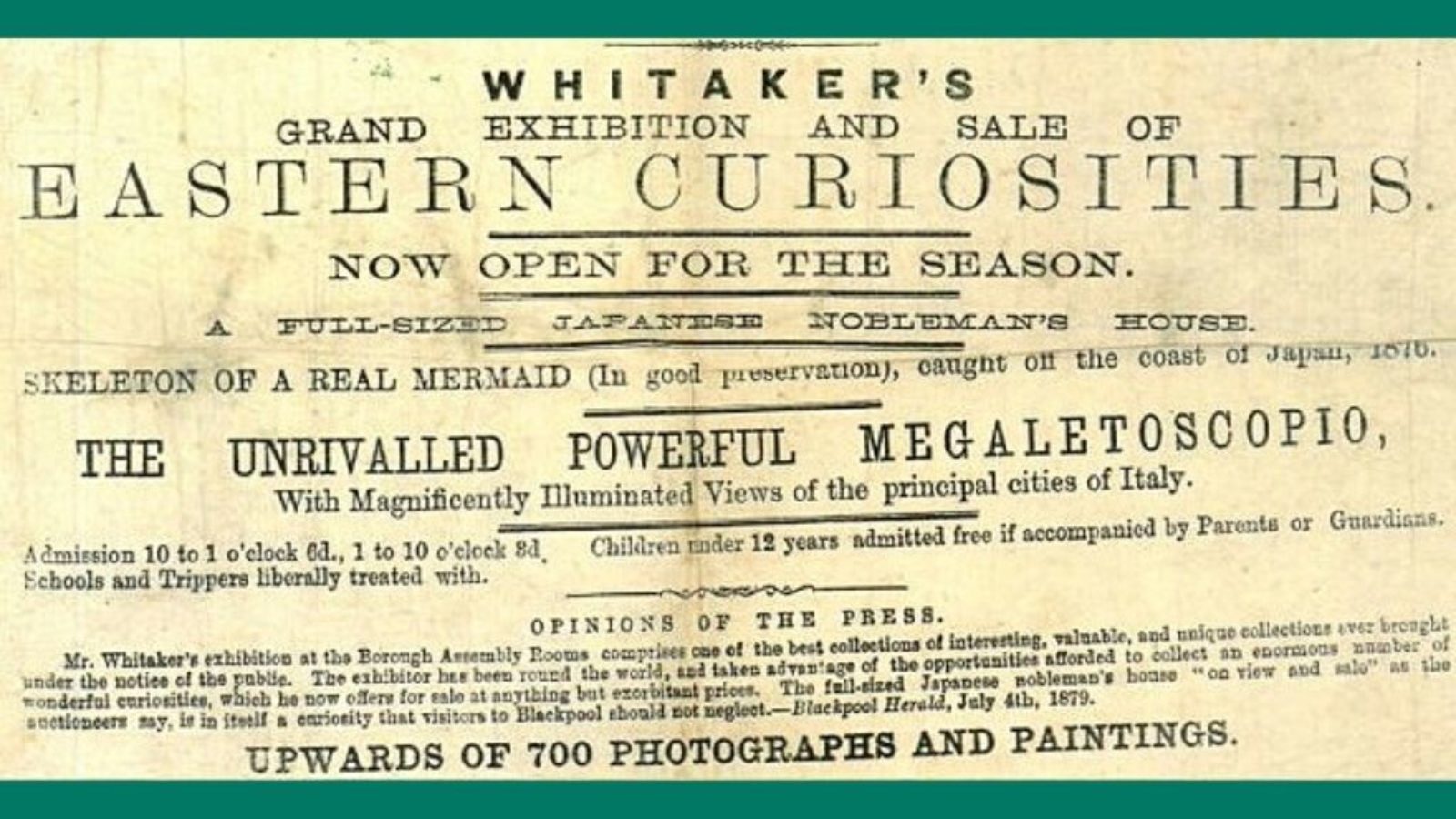
A Full Sized Japanese Nobleman's House
Amongst the treasures Whitaker brought to Blackpool, the Blackpool Herald was most taken with the Japanese nobleman's house:
"brought to England bodily, which well represents the habits of the Japanese, so different from anything we see in England. The house contains a seat for the Mikado on his ceremonial visits...We understand that this is the same as that exhibited at the Paris exhibition, and of which the London Times spoke so highly."
The exhibition in question was the 'Exposition Universelle' of 1878, which was the third World's Fair to be held in Paris. These international exhibitions were designed to showcase the industrial, artistic and cultural achievements of nations, largely inspired by the commercial and popular success of the Great Exhibition at the Crystal Palace, London in 1851. Amongst the highlights of the Paris exhibition of 1878 was Alexander Graham Bell's telephone, Thomas Edison's phonograph and the recently completed head of the Statue of Liberty before its French manufacturers transported it to New York. Each nation also had their own pavilions, built in their unique architectural styles, to display their cultural achievements. On the 11th February 1878 the Shipping and Mercantile Gazette reported that "A Japanese carpenter, famous for his skill is to proceed to France, to erect a model Japanese house in that part of the Paris Exposition grounds assigned to Japan."
The Japanese pavilion received significant praise. As the Northwich Guardian reported 'they have asserted themselves as rivals with Europeans on their own ground of carpentry, cabinet work and ornamental metalwork.' But special attention was paid to the model house.
"The small scale of a Japanese house and its room, the largest of which is a mere boudoir compared with out apartments, no doubt leads to that peculiar neatness of joinery of the woodwork, and the framing the panels so tastefully ornamented with through cut tracery of flowers, birds or geometrical ornament, which form the walls and ceiling of this nobleman's room, the dimensions of which are only about 18ft square and 8ft high. What is so remarkable in the construction of this, as of all other rooms and houses of Japan, is that not a single nail, screw or bolt is used, the whole being fitted together by accurately cut mortice joints, enclosing panels which slide with perfect ease and fit closely to form doors and windows where required. The windows in this model house are simply filled in with semi-transparent paper, but in reality they have talo instead of our glass. The floor is covered with fine matting softly padded underneath and used as a bed if needed."
Quite how Frederick Whitaker acquired the house after the exhibition finished in November 1878 is unknown, but there is little doubt that at the time it would have been an entirely novel sight in Blackpool. We may also never know what happened to the model house, however there is an interesting advert in the Manchester Weekly Times on 11th October 1879 for a new attraction, "a Japanese house erected in the premises of Mr John Mark St Annes Square" which matches the description.
Skeleton of a Real Mermaid
The extraordinary claim to have a 'skeleton of a real life mermaid' was a common boast for collections of curiosities and sideshows in both America and Britain during the Victorian period. It was a fad which is said to have been started by the 'Greatest Showman' and circus owner P.T Barnum, who coined the phrase "there is one sucker born every minute."
Barnum's 'mermaid' had been purchased from Japanese fishermen by American sea captain Samuel Barrett Edes in 1822 using $6000 of the ships expense account. The mermaid was put on display in London before Edes' son sold it to Moses Kimball of the Boston Museum, who then showed it to Barnum. The showman saw the potential public interest in such an object and rented it from Kimball for $12.50 a week. Barnum then generated publicity by creating a fake naturalist 'Dr J.Griffin' who claimed to have caught the mermaid off the coast of South America. "Griffin" was in fact a man named Levi Lyman, an associate of Barnum. They then produced 10,000 leaflets which described the mermaid in detail and placed the skeleton on display for the paying public.
The success of Barnum's mermaid spurred many imitations, with showmen both importing examples from Asia and also constructing their own. Barnum's original mermaid is thought to have been destroyed in a fire, but there are hundreds of examples still in existence, many in British museum collections including The British Museum, The Science Museum and Hull Maritime Museum. Most of the specimens that survive combine the bodies of fish and monkeys wired together and preserved through taxidermy. When forensically examined the specimen from the collection at the Buxton Museum and Art Gallery was found to contain wood, cloth, wire, carved bone and fish scales. She also had snails for eyes, protein glue for skin and human hair on her head.
Interestingly however, these items were not originally manufactured to con gullible visitors out of their money. These 'mermaids' were in fact built by Japanese fishermen as depictions of water spirits called Ningyo. There are reports going back to the 1820's from the director of the Dutch trading company in Nagasaki Bay which describe these depictions of Ningyo in Japanese shrines and being sold by a fisherman. It is made very clear that these were artistic representations of the spirit, not 'real' Ningyo.
It is very possible that Frederick Whitaker picked up his Ningyo during his travels in Japan. It is interesting however that our hand bill claims that this was "caught off the coast of Japan, 1876." This suggests that either Whitaker believed it to be genuine, or was following in the best traditions of P.T. Barnum and adding a sparkle of showmanship to his exhibition.
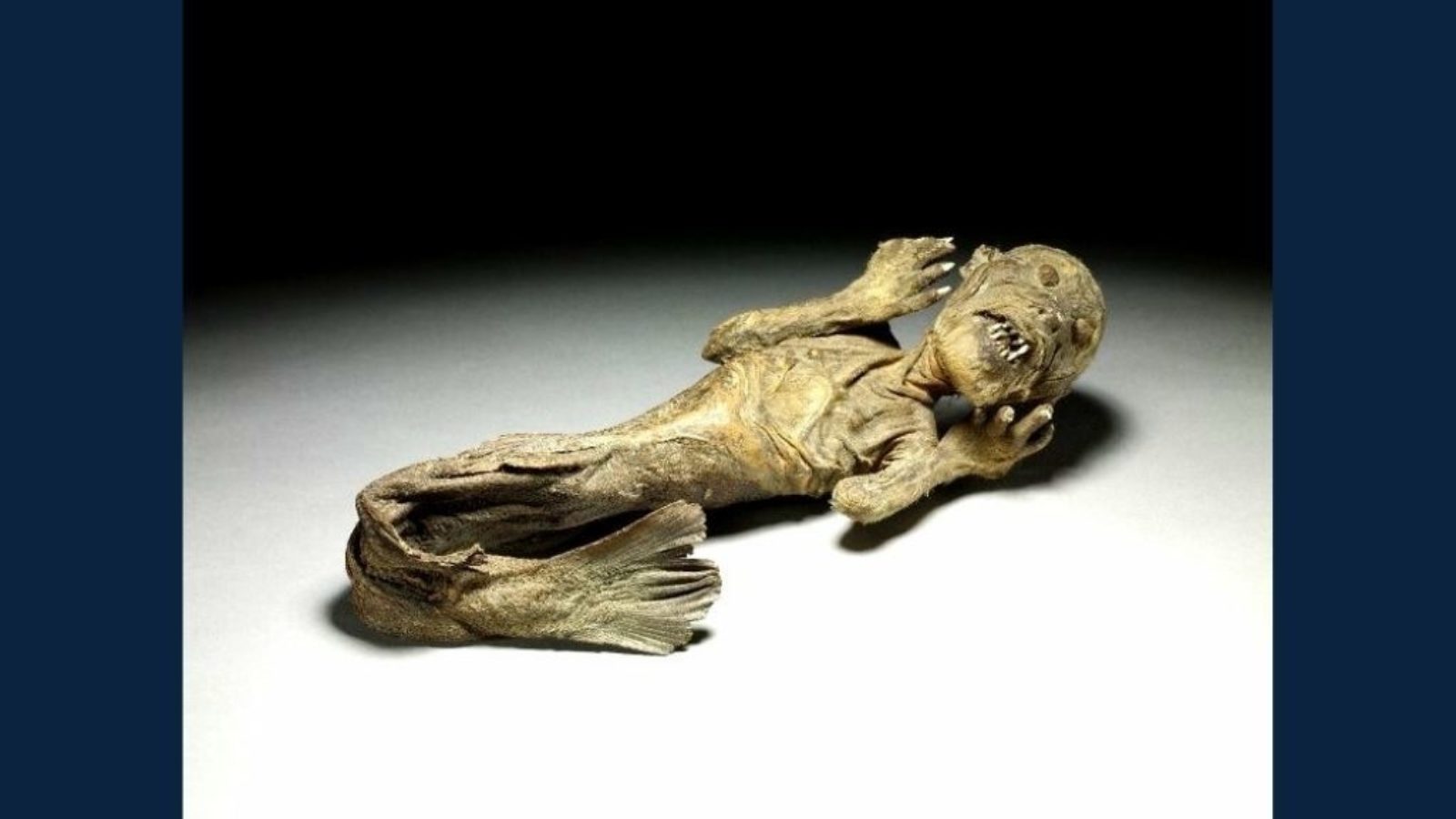
The Unrivalled Powerful Megaletoscopio
Whilst Whitaker's mermaid might have been a thing of myth and superstition, the final highlight on his hand bill was an exhibit of technological achievement, "the unrivalled, powerful Megaletoscopio."
More commonly known as the Megalethoscope, this was an optical device created by Swiss born optician and photographer Carlo Ponti in 1862. Ponti studied in Paris until he settled in Venice in 1854, where he invented the Alethoscope, a device for viewing photographs as both day and night scenes using reflective and transmitted lights. The Megalethoscope was a refined and enlarged version of this machine in which the photographs were viewed through a large lens which created the optical illusion of depth and perspective. Ponti would also modify the photographs using pinholes, scratches and coloured paper, which when viewed through the Megalethoscope created dramatic day and night effects, depending upon the movement of the light source. Ponti and others went on to create hundreds of images of famous Italian landscapes, architecture and other exotic locations that were still inaccessible to the average Victorian.
Whitaker's Megalethoscope was certainly the first seen in Blackpool. As the Blackpool Herald remarked on the novelty of:
"A megaletoscope gives splendid illuminated views of some of the principle places of interest in Italy, and a magnificent view of Vesuvius during an eruption. These views are an exquisite work of art, and are sure to be attractive. Altogether this exhibition is one of a kind never seen before in Blackpool."
The Megalethoscope joined many other forms of optical devices such as the zoetrope and peep shows which were exhibited by travelling showmen at fairs, only really to become obsolete with the invention of cinema at the end of the 19th century.
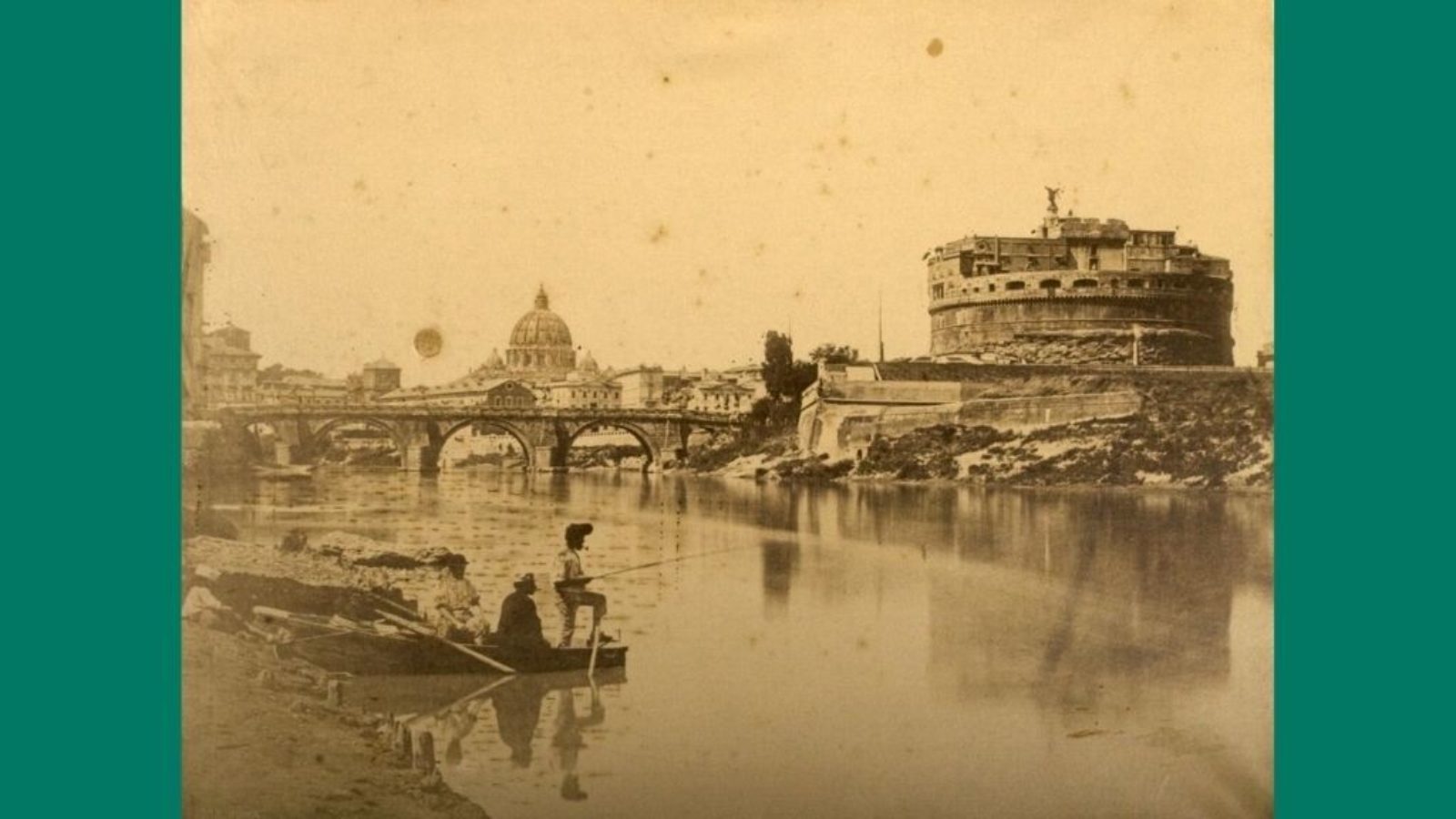
After the Grand Exhibition
It is difficult to say how many people visited the Grand Exhibition of Eastern Curiosities. By the 22nd August Whitaker made the entry free, because "he wishes to dispose of the collection before the close of the season. The goods have all been re- marked at low prices."
Whitaker evidently made enough money to re-establish himself as a woolstapler and auctioneer in Halifax, and later traded at the Wool Exchange Tavern in London. Interestingly, in 1887 he amassed debts of around £8000 and fled to America to avoid his creditors. By November 1887 he returned and submitted to the court and was declared bankrupt.
Despite this unsavoury episode, Whitaker was evidently still well regarded in Halifax. His death in London in June 1897 was announced with sadness in the papers and he was buried at Stoney Hoyd cemetery in Halifax on the 5th June.
As for the Borough Bazaar and Theatre, the owners struggled to make it profitable and sold the building in December 1879 for £3000. The theatre was renamed the Criterion and hosted variety acts for 1881-3, when it became known as the Alpine Hall, thanks to the residency of Professor Andre and his Alpine Ladies Choir. In 1885 the building was purchased by Thomas Bannister, a draper who had previously owned a shop in the Palatine building. Bannister's Bazaar remained a fixture of the town until the family retired in 1927, when the building was purchased by theatre promoter and composer Bert Feldman.
Feldman was looking to create a venue to compete with Lawrence Wright's 'On with the Show' on the North Pier in 1926. He began by altering the ground floor to create a large auditorium and stage area. He turned the smaller upstairs theatre into Feldman's Repertory Theatre, with a separate entrance, which ran local repertory plays. Feldman's became a popular venue in the town until 1952 when it was sold and became the Queens Theatre. Over the years it hosted many famous names including Morecambe and Wise, Tony Hancock, Tommy Cooper and The Beatles.
The Queens closed in 1973, when it was demolished and replaced with a C&A, now occupied by TK Maxx. All that marks the site of the Borough Bazaar now is a blue plaque installed by the Civic Trust.
